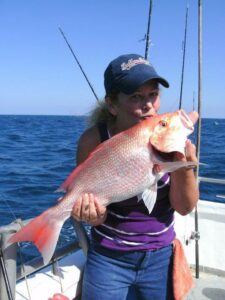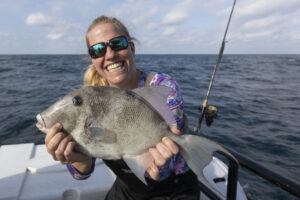
Photo: Capt. Frady
Have you ever wondered why regulations like size limits, seasons, and bag limits are set the way they are? In this series of articles, we’ll explore the logic used to set fishing regulations. We’ll explain why these types of regulations vary by species and explore the factors that are considered when we set them.
Fishing seasons are arguably one of the most important fishery management decisions made by the Council. Simultaneously, they are some of the most complex. Decisions about when to open a fishing season and/or how long to keep a fishing season open directly impacts fishing behavior and can even impact the fish themselves. The following article aims to outline the different factors that are considered when fishing seasons are set.
It’s important to begin the conversation about setting fishing seasons with the baseline understanding that federally managed species must be managed with an annual catch limit. This annual level of harvest is set by the Council based on advice from stock assessments and the Council’s scientific advisors, the Scientific and Statistical Committee. Once an annual catch limit is determined, the Council is tasked with setting fisheries management measures, such as size limits, seasons, and bag/vessel limits that aim to achieve those annual harvest targets. Seasons are one of the most direct way to manage harvest.

Photo: Capt. Murphy
Since factors like weather, fishing behavior, and fish activity vary so much across the region, setting seasons that appease everyone is incredibly challenging. The Council starts by considering the average rate of harvest per day, which varies throughout the year and by species. Most species experience high rates of harvest in the summer when
the weather is nice and people are out fishing. However, opening a fishing season when fishing is good can adversely impact season length. The better the fishing is, the shorter the season has to be to ensure that annual catch limits aren’t exceeded.

Photo: Gavin Redinger
Fishermen from different areas of the Gulf often disagree on the best time to open a season. Generally, eastern Gulf fishermen tend to like summer and spring seasons because they capitalize on tourism and don’t conflict with hunting season. Western Gulf fishermen tend to prefer summer and fall seasons because the wind doesn’t always cooperate in spring. Southern Gulf fishermen like winter seasons but the weather keeps most northern Gulf fishermen off the water in winter.
If balancing opposing needs of fishermen isn’t enough, we also have to consider ideal season timing from the fish’s perspective. Fishermen tend to support season closures during peak spawning. Interestingly, the effectiveness spawning closures is not proven across the board. Species that don’t exhibit special spawning behaviors may not benefit from spawning closures. In those cases, no matter when you harvest a fish throughout the year, it’s always before the next time it spawns- it could be one day before the next spawn or entire year. In those cases, it’s more important to set a minimum size limit that aims to allow those fish to mature and spawn before they’re big enough to be harvested.
There are some species that do exhibit unique spawning behaviors and benefit from spawning closures. For example, grouper aggregate and males display more aggressive behavior when they’re in spawning. This makes them uniquely susceptible to fishing pressure during the spawn so, the Council uses a spawning closure when fishing recreationally beyond 20-fathoms and created a few unique closed areas to alleviate some of the pressure on groupers during February and March.
Setting fishing seasons that properly constrain catch to the annual catch limits while simultaneously creating the maximum benefit to fishermen across the Gulf and the fish themselves is no small task. Each species requires its own unique management strategy based on biological characteristics, stock condition, and the needs of the anglers that target them. Deciding when, how, and what types of regulations to set for different species can be very complex. Finding a balance between conservation, fishing opportunity, and flexibility for anglers can be daunting. This is why it is critical for managers and stakeholders to work together in the regulatory process.

Photo: Return ‘Em Right
